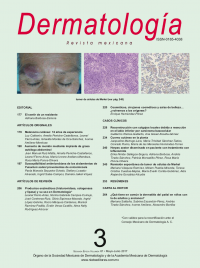Dermatol Rev Mex. 2017 mayo;61(3):190-196.
Ruiz-Matta JM, Peniche-Castellanos A, Fierro-Arias L, Arellano-Mendoza MI, Ponce-Olivera RM
Departamento de Cirugía Dermatológica, Hospital General de México Dr. Eduardo Liceaga, Ciudad de México.
Resumen
ANTECEDENTES: el mentón juega un papel importante en la percepción de la estética facial. La prominencia horizontal del mentón puede mejorarse con el implante de grasa autóloga; sin embargo, en la actualidad este método dirigido a incrementar la proyección de esta región anatómica es poco estudiado. Se realizó un estudio piloto en siete pacientes para aumentar el mentón con implante de grasa autóloga abdominal.
OBJETIVO: comunicar los resultados de aumento del mentón mediante el implante de grasa autóloga abdominal.
MATERIAL Y MÉTODO: estudio piloto, prospectivo y descriptivo en el que se obtuvo tejido graso del área del abdomen y se inyectó en el área del mentón a nivel del tejido celular subcutáneo en pacientes de la consulta externa de Dermatología del Hospital General de México, de mayo a diciembre de 2016. Se evaluaron las variables demográficas y la satisfacción del paciente. Se les aplicó el cuestionario de satisfacción del paciente al inicio del estudio y a un mes de seguimiento, con control fotográfico.
RESULTADOS: se reclutaron siete pacientes, cuatro mujeres, con media de edad de 32.7 años. El promedio del índice de masa corporal fue de 22.9 kg/m2 (19.3-27.9 kg/m2) y el promedio de volumen inyectado fue de 3.85 mL (3-5 mL). El 85% dijo sentirse muy satisfecho con el procedimiento y 15%, satisfecho.
CONCLUSIONES: se propone esta técnica barata y segura como alternativa a la cirugía con prótesis de mentón.
PALABRAS CLAVE: mentoplastia, injerto de grasa autóloga, aumento del mentón.
Chin augmentation with autologous abdominal fat grafting.
Dermatol Rev Mex. 2017 May;61(3):190-196.
Ruiz-Matta JM, Peniche-Castellanos A, Fierro-Arias L, Arellano-Mendoza MI, Ponce-Olivera RM
Departamento de Cirugía Dermatológica, Hospital General de México Dr. Eduardo Liceaga, Ciudad de México.
Abstract
BACKGROUND: Chin plays an important role in the perception of facial aesthetics. The chin’s horizontal prominence can be improved with autologous fat grafting; however, this method is currently being evaluated as an option to improve this anatomical region. A pilot study was performed in 7 patients to increase the chin volume with autologous abdominal fat grafting.
OBJECTIVE: To communicate the results of chin augmentation with autologous abdominal fat grafting.
MATERIAL AND METHOD: A pilot, prospective and descriptive study was done in which fat tissue was obtained from the abdominal area and injected into the chin at the subcutaneous tissue level in patients from Dermatology external consultation of General Hospital of Mexico, from May to December 2016. Demographic variables and satisfaction of patients were assessed. A satisfaction questionnaire was applied to each patient at the beginning of the study and at one-month follow-up, with photographic control.
RESULTS: Seven subjects were recruited; 4 women, with a mean age of 32.7 years. The mean body mass index was 22.9 kg/m2(19.3-27.9 kg/m2). The average injected volume was 3.85 mL (3-5 mL); 85% of the subjects self-reported as very satisfied and the remaining 15% reported as satisfied with the results immediately after chin augmentation.
CONCLUSIONS: The authors of this pilot study propose autologous fat grafting as a low-cost and safe technique for chin augmentation, which could be an alternative to prosthetic chin augmentation.
KEYWORDS: augmentation mentoplasty; autologous fat grafting; chin augmentation

